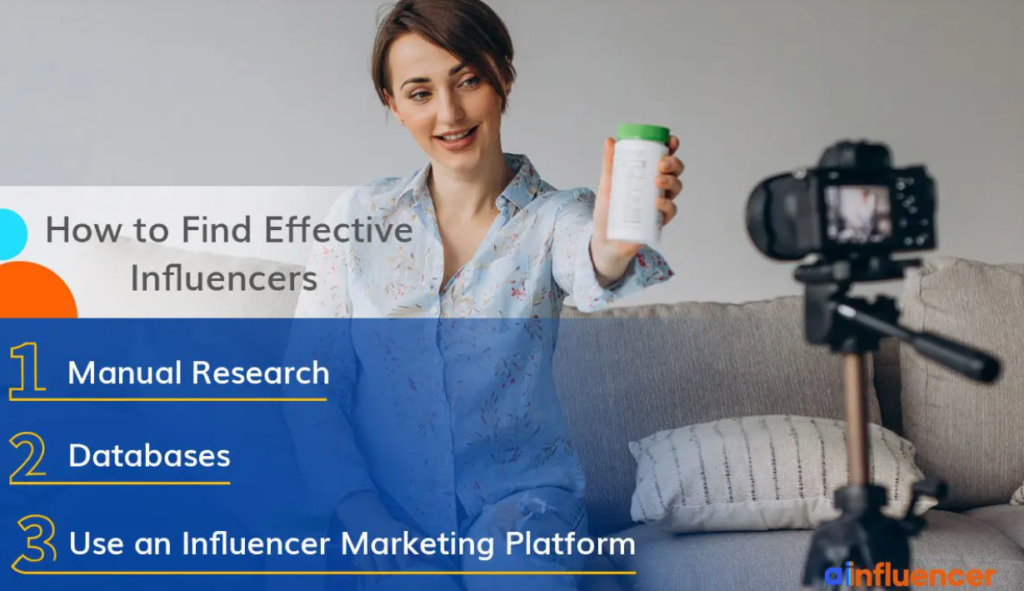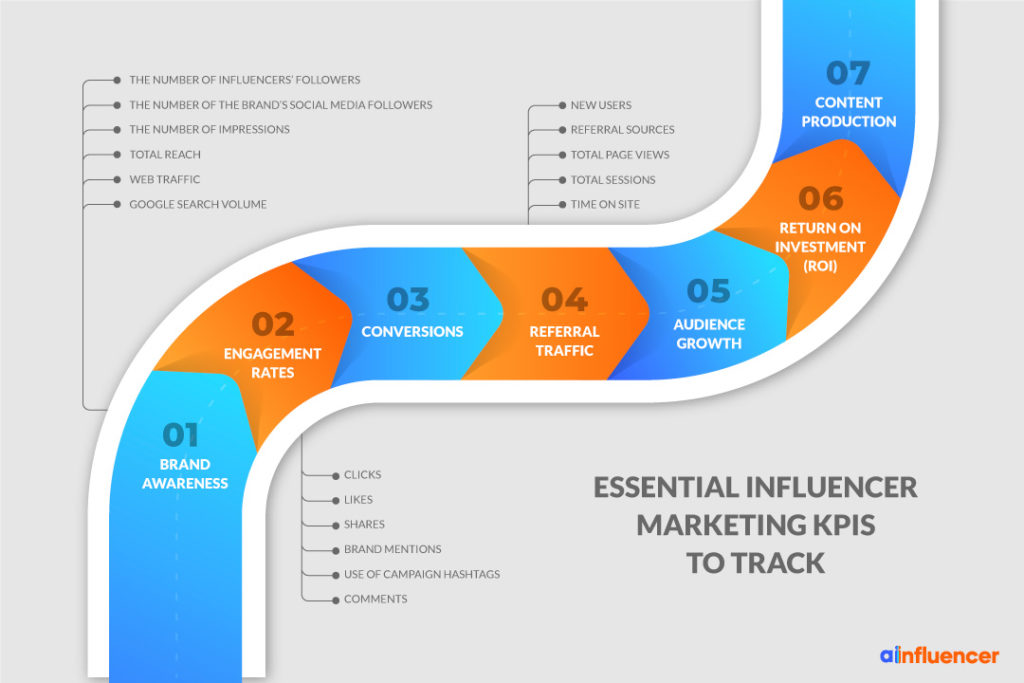As social media has grown in popularity, so too has influencer marketing. While the concept of influencer marketing is simple, measuring its effectiveness can be difficult. There are a number of key performance indicators (KPIs) that can be used to measure the success of an influencer marketing campaign.
If you wonder what influencer marketing KPIs you should track to identify success and improve that success, then you’re at the right place.
Below, we’ve listed the most important marketing KPIs that will help you track your progress, measure influencer marketing success in meeting your goals, etc.
What does a successful influencer marketing program look like?
Increasing leads and revenue and lowering customer acquisition costs are two things that every marketing team is accountable for. However, some of the most significant accomplishments are more subtle.
Your boss, for example, knows the ROI of a campaign that resulted in high sales right away. Other accomplishments, such as higher follower counts or website traffic, may not elicit the same level of enthusiasm from your boss. You know deep down that tracking the customer journey entails celebrating small victories that have a direct or indirect impact on the brand’s bottom line.
In order to track the customer journey properly with your influencer marketing program, you need to set influencer campaign KPIs and assign important metrics to those KPIs. This method will assist you in following the S.M.A.R.T. (specific, measurable, attainable, relevant, and time-based) principle for goal-setting.
How to set up and run influencer marketing campaigns?
To create and launch influencer marketing campaigns you need to go through the following steps that guide you through the process.
- Outline the goals
- Choose the right type of influencer campaign (gifts, contests and giveaways, social media takeover, affiliate marketing, sponsored content, guest blogging, brand ambassador program, etc.)
- Define target audience
- Pick the right social media platform
- Find effective influencers
Choosing the right influencer is a game-changer in the process of running your influencer marketing campaign. There are three main ways to find them:
- Manual research
- Database
- Use an influencer marketplace

Using an influencer marketplace, especially those that are free helps you save a lot of money, time, and energy while making your influencer marketing campaign a success.
Ainfluencer is one of the free Instagram influencer marketing DIY marketplaces. This full-service app acts as a middleman in the influencer marketing campaign and lets you either sign up as a brand to find and invite your target influencer or as an influencer to make offers for brands to collaborate with.
What influencer marketing KPIs can help you track the performance of your influencer marketing campaigns?
We’ve put up a list of key performance indicators (KPIs) that you may use when planning your next influencer marketing campaign.

#1- Brand awareness
Brand awareness is the level of recognition a company’s name and/or logo has among the public. It can be measured through various methods, including survey results, consumer research, and market share analysis. A high level of brand awareness can benefit a company because it may lead to increased sales and customer loyalty.
While it may appear to be a simple metric, brand awareness is one of the important KPIs for influencer marketing to consider. Tracking influencer post reach and impressions is a common way to measure brand awareness.
The difference between reach and impressions are as follows:
1- The number of individuals who see your post is referred to as its reach.
2- The number of times your content was displayed to your audience is referred to as impressions.
With this in mind, here are the best influencer marketing KPIs for measuring brand awareness:
- The number of influencers’ followers: The potential reach is determined by the overall size of your influencers’ audiences.
- The number of the brand’s social media followers: Has your brand’s audience expanded as a result of the campaign suggesting increased brand awareness?
- The number of impressions: The number of times the content was displayed.
- Total reach: The total number of people who have seen campaign content.
- Web traffic: The increased number of unique visitors.
- Google search volume: The number of people searching for your brand name.
#2- Engagement rates
Monitoring the engagement rate is an important influencer marketing KPIs. Engagement rate is the percentage of people who interact with a website or social media post. It can be used to measure how frequently people are interacting with a piece of content.
Keep track of the following metrics to determine your influencer engagement rates:
- Clicks: Clicks are a way to determine your audience’s level of interest.
- Likes: One of the simplest influencer marketing metrics to quantify the buzz around your influencer content is likes.
- Shares: One of the KPIs for influencer marketing that you should track is shares. The more people recommend your content to their social media circles, the more likely they are to recommend your products too.
- Brand mentions: You can track where your content is being discussed and amplified by measuring brand mentions.
- Use of campaign hashtags: Hashtags are a great way to encourage conversation and connect with people who are interested in the same topics as you, drive traffic to your website or blog, etc.
- Comments: You can detect whether or not your audience loves your content based on the number and nature of comments.
One of the other important influencer marketing KPIs you should look at when you’re tracking engagement is cost per engagement (CPE).
Cost per engagement (CPE) is one of the marketing KPIs that helps companies determine how much it costs to acquire a new customer. This metric can be used to compare the cost of acquiring a new customer against other marketing expenses. CPE also shows how efficiently a company is using its marketing resources.
#3- Conversions
When most marketers want to measure influencer marketing success, they think of conversions. Although tracking sales that happened when the influencer marketing campaign was running is an easy way to track conversions, conversions don’t always have to do with sales, and there are other conversion rates you can be monitoring as well.
More accurately, conversions occur when the audience of your marketing campaign completes a desired action. Signing up for a newsletter, downloading an ebook, clicking on a link, or doing anything else you want your prospects to do is an example of this.
#4- Referral traffic
The amount of traffic the campaign drives to your site is a marketing campaign KPI that is also worth monitoring to determine the success of your marketing efforts. You can use tools like Google Analytics to track the rise in traffic. You can use it to track metrics such as the ones listed below for certain time periods.
- New users
- Referral sources
- Total page views
- Total sessions
- Time on site
You can use methods such as promo codes, UTM parameters, and affiliate links to track and attribute conversions when working with influencers.
#5- Audience growth
You may assume that audience growth is similar to reach and awareness, but there is a big difference: Just because the campaign had an effect on someone doesn’t mean they were successfully brought into the fold.
For example, when a user clicks on a new blog post while scrolling through your Facebook newsfeed, and then from the blog clicks through to a website. According to marketing campaign KPIs such as reach and traffic, this would be a success. But if the user checks out the site, leaves the site, and never thinks about it, then the influencer marketing campaign isn’t successful according to the audience growth KPIs.
But now, imagine the user checks everything out and decides to follow a brand/business on Facebook or other social media platforms to get updates about promotions, new products, discounts, etc.
Again, the audience growth KPI is critical here since it provides a complete view of your success. Remember, you’re not just attempting to reach as many people as possible; you’re also attempting to turn them into raving and devoted fans.
You can utilize social media site analytics to track audience growth by monitoring your followers and seeing how many new ones you get during the campaign, then comparing the growth to pre-campaign figures. You can do the same thing with your email list and compare how many people signed up during the campaign to how many people signed up previously.
#6- Return on investment (ROI)
Return on investment is arguably one of the most important influencer marketing KPIs to measure. To know whether or not the money you’ve spent on influencers is generating a positive ROI and influencer marketing is a good use of your marketing budget, select the KPIs relevant to your goals and get insights into your campaign performance.
If the exact amount of revenue generated as a result of a campaign is higher than the amount invested in the influencer campaign at the start, then you have a positive ROI.
Another technique to evaluate ROI is to look at the earned media value (EMV). This entails estimating the value of the interactions generated by the campaign, such as reach and engagement. Because these brand engagements occur on channels not owned by the brand, including the influencer’s channels, blogs, and the press, this is referred to as ‘earned’ media value.
#7- Content production
Content production is one of the important influencer marketing KPIs to track when you want to measure influencer marketing effectiveness. When you work with influencers, it’s usual for them to be in charge of content creation. You’ll have varying degrees of control over the content they create, depending on your agreement.
The influencers can also encourage their followers to create content which is called user-generated content (UGC). You can determine how well your partnership is going by tracking the number of UGCs that were created.
You can track the value of content creation for your influencer marketing in two ways. These are: the amount of content produced and content quality.
Conclusion
In conclusion, while there is no one definitive answer to the question of what constitutes success when it comes to influencer marketing, there are a number of key performance indicators (KPIs) that can be used as a guide. By understanding and tracking these KPIs for influencer marketing, brands can develop a better understanding of how well their influencer marketing campaigns are performing and make necessary adjustments to ensure that they are achieving the desired results.
The seven essential influencers marketing KPIs to focus on are as follows:
1. Brand awareness
2. Engagement rates
3. Conversions
4. Referral traffic
5. Audience growth
6. Return on investment
7. Content production
Audience engagement is one of the most crucial indicators to examine both before and after investing in influencers. Because engagement is a factor in many social media algorithms that determine how many people will see a post, this statistic is more significant than ever.









